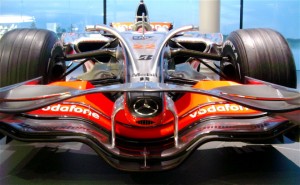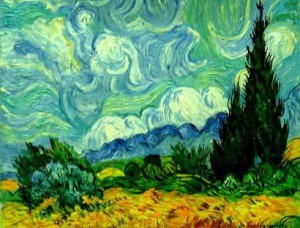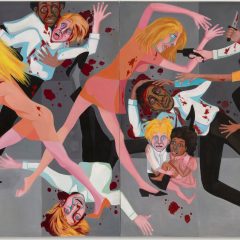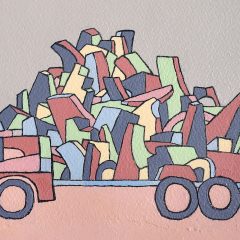The international space station should look like this, the McLaren racing headquarters/factory in Woking, England pictured below. Modelled on a race track the eye glides everywhere with ease. Lines are lost around bends only to reappear from behind us. At the entrance we catch a glimpse of a Tony Cragg in someone’s office. Then we enter the Elysian Fields of past Formula 1 (F1) car legends that have always embodied the concept of form following function. They were once the fastest cars on earth guided along the outer limits of earthbound speed, vehicles on the verge of becoming sarcophagi, by pilots that sometimes never returned.
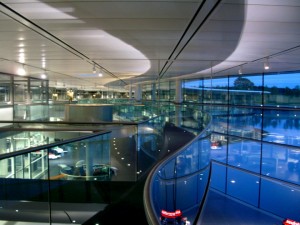
So what are the latest aerodynamic forms of the high end car industry? I went to see my friend Antony Sheriff, the managing director of McLaren, to find out. First we looked at the F1 area. Here the answer is: exploded. This burst has multiplied and deployed the planes of the car to produce a train of wings, bumps and slits to corral every breath of air that touches it.

It’s a Lucio Fontana/ Robert Morris collaboration. Counter-intuitively their leading and trailing edges are sometimes distorted in ways reminiscent of Salvador Dali when time and dreams extrude and warp forms into lethargic putty.
The channeled air feeds the gaping funnels oxygenating and cooling the engine and the brakes. Because flat surfaces aren’t aerodynamic they need to be distorted in order to control turbulence and help put the perturbed air back together behind the car in a drag efficient way as well.
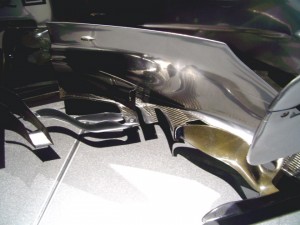
When the car is moving at 300mph I imagine the strands of air momentarily glued to its surface to be as dense as white lead oil paint. When it blasts through space it creates a momentary extrusion of the atmosphere. Van Gogh‘s windy southern France skies come to mind from when he directed his speeding eye there.
Potential power leads to that power being used. Even at rest the car’s form provokes speed through the evocation of speed. It aerodynamically empowers brawn (moter) and brains (pilot) to a frenzied black and white checkered salute, the semaphore of victory.
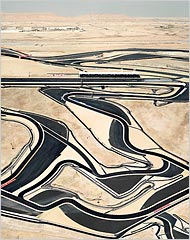
Few people outside of the F1 world realize just how violent car transport is. I once broke down on the side of a high speed highway. I had to quickly get the family out of the car and to the safety of a steep embankment before we were sucked under a truck. The traffic was all sound and fury with even the humblest family car screaming like a V1 rocket.
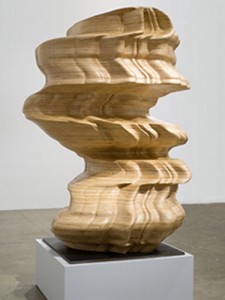
Father’s Day Gift Ideas
Over in the commercial car sector of the headquarters there is a manual assembly line of about 18 or so stations. There isn’t a speck of dust in this area where clients can watch their $400,000 baby come to life. Some men would marry these machines.
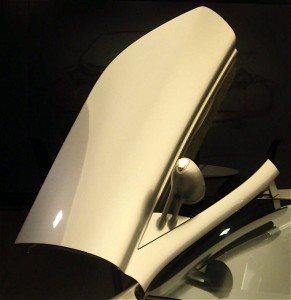
These cars are guided by the same design principles as their F1 brethern: form follows function. Face to face with open hoods that look like super hero armour I asked Antony about Richard Prince. He explained that the hood size has always been the status symbol. The bigger the hood the bigger the engine, etc. Can a hood be art?
“Design is often an alibi for doing art. Function is faked and is symbolic as opposed to substantive. An Alessi pepper grinder is art. It doesn’t push the function. Good design pushes aesthetics and function.” The hood is design on a Mercedes.
With Antony’s spouse Daniell Bodor we wondered why art galleries were exposing so much design: “Because it is serious and yet understandable” said Danielle. I agree. Design is definitely bridging gaps between spectators and art.
Engines and the bodies that surround them will change with environmental imperatives. Will these beautiful objects go the way of the Concorde? Perhaps, but form will always follow function somewhere. We’ll find other forms of speed and power in which to encapsulate ourselves.
